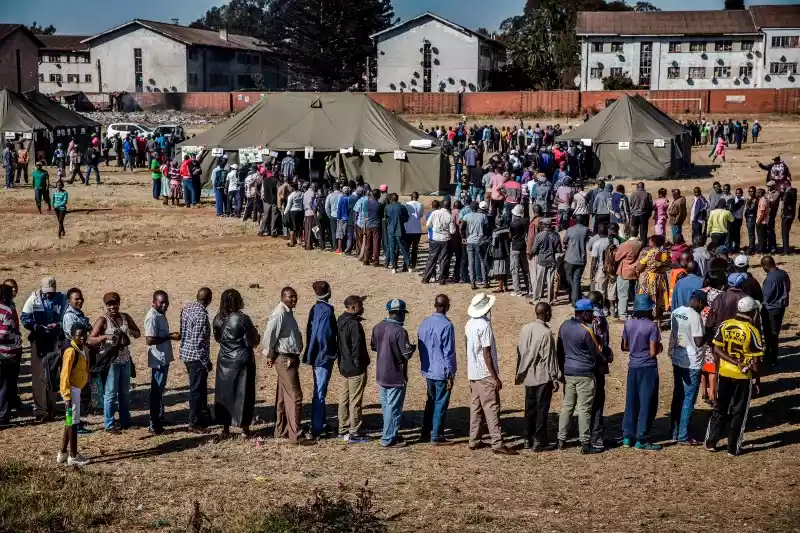
Zimbabwe, in common with most African countries, has a very large youth cohort, and such “bulges” are argued to have important political consequences, providing either a dividend for economic growth or a potential political disaster.
The youth of Zimbabwe have experienced significant and sustained adversity for the past 20 years. Most, and including the well-educated, are unemployed — except in the informal sector — and have witnessed every single election since 2000 resulting in no political change, dispute over the results, and too frequently witnessing or experiencing political violence.
With elections taking place in August, it is therefore of considerable interest to explore whether the youth will vote; how the youth might vote; and how they might react to yet another disputed election.
Using the data from Afrobarometer, these issues are examined.
The data suggests the effects of political violence, sustained economic deprivation, and a lack of political trust in the state, the government, political parties, and government officials, have resulted in a youth cohort that displays little agency.
However, when it comes to voting the youth might provide a major surprise if the elections meet the conditions of a bona fide free and fair election. But it is doubtful that an election that fails their expectations will result in the youth protesting in any serious fashion.
Supporters of the ruling Zanu PF claim they intend to give President Emmerson Mnangagwa five million "virgin" votes in Zimbabwe's harmonised elections in 2023.
The census of 2022 revealed that the number of persons who turned 18 and could eventually become Zimbabwe's future voting population has grown.
- Africa hit hard by high e-waste pollution
- Africa is paying dearly for the Russian/Ukraine conflict
- Pathways for repurposing resources are long overdue in developing countries
- Poor co-ordination makes it difficult to see where African food systems are going
Keep Reading
All political parties, including Zanu PF, turned their political attention to this group.
Zanu PF has brashly asserted in its slogans and campaigns that it has already won 4.5 million votes and that it wants to grow the party to a monolithic five million members.
The CCC has capitalised on its youthful image and believes that, come election day, the youth would identify with them.
The youth in Zimbabwe are sought-after as a result of this competition, but they may also be a poisoned chalice. The effectiveness of the youth vote will depend on how the elections in 2023 turn out.
Elections in Zimbabwe often confound even political scientists.
It is extremely rare that governments that make life worse for the citizens get re-elected, and even rarer that they are returned to power with an increased majority: it is a standard rule of thumb in political economy that governments that fail to improve the lives of citizens are thrown out in the expectation that another party will do better.
For example, despite all the indications to the contrary in 2012, ZanuPF was re-elected with two-thirds majority in 2013.
Even when the MDCT won both the parliamentary and presidential elections in 2008, they were unable to translate the victory into political power, and the outcome of the presidential re-run three months later, a very bloody affair, only resulted in power sharing.
A comparative example is the speculation that the middle classes in South Africa are unlikely to vote for the ANC in the next elections because of the failures by the government to deliver public goods and services, and especially because of the extreme load-shedding that is taking place.
Whilst Zanu PF can claim fiefdom over political power due to the Liberation War, it is obvious that Zimbabwe’s population is getting younger by the decade with most of the population not alive before 1980 – nearly 70% of Zimbabwe’s population is now under 35 years.
Most of these young people can only remember hard economic times, apart from a brief period between 2009 and 2013 during the inclusive government.
Most of Zimbabwe’s young, whether educated or not, can only earn a meagre living in the informal sector, and many have fled the country for greener pastures.
The youth in Zimbabwe are little different in most respects to their counterparts in most Sadc countries.
However, Zimbabwean youth were differentiated by their greater desire to migrate and the lowest propensity in Sadc for participating in protest or demonstration.
Earlier work on Zimbabwean youth also demonstrated a strong propensity for them to vote, but a very low frequency of public or political participation, as well as great differences between rural and urban youth, where the former were much more likely to participate publicly (contact officials) and politically (attend rallies or work for candidates).
Rural youth also have much greater political trust than their urban counterparts.
Most political commentators would attribute this difference to the extensive clientelism and patronage networks established in the rural areas, together with the use of coercion against those not supporting Zanu PF
All of this suggests that the conditions are propitious for a change of government in the 2023 elections if the youth do what their neighbours in Zambia did in 2022. So, can this happen in 2023? And are these kinds of conditions that lead the youth to become more active, as seems the case in several Sadc countries?
A recent survey pointed out that the young in Zimbabwe were less likely to vote than the older population.4 41% stated that that they were not registered to vote, and only 52% were likely to vote.
However, it is worth noting that the highest frequencies of all respondents who were not registered to vote came from Masvingo (58%) and the Matabeleland provinces (53%).
Confusingly, those from Masvingo were the second most likely to vote of all provinces (78%), whilst those from the Matabeleland provinces were the least likely overall (57%).
There is a contradictory picture here: the youth are not registered in significant numbers – which may reflect the difficulties in getting registered or “apathy”– but they also intend to vote which does not suggest apathy.
With elections coming in less than two months, it would seem a good time to have a look at the youth in Zimbabwe and try to assess what their contribution will be to the elections and to the outcome of the elections.
The purpose behind this analysis of the public views of the youth of Zimbabwe was to determine whether they would vote in 2023; who they would vote for: and what they would do if their desires were thwarted.
As pointed out, and in greater detail elsewhere , the material conditions for the youth could not be worse, and these are argued to be the conditions that lead to protest and civil disturbance – the effects of a “youth bulge” and the combined effects of education, unemployment, high dependency, and the failure of the government to address their aspirations.
It was seen that a small majority of the youth do vote consistently over the years, and more so as they get older and come to grips with the realities of life outside of family, school, and tertiary education.
Much greater numbers of the youth state that they voted in the last election, and although this may be greater amongst the rural youth than the urban, it is evident that there has been increased voter registration amongst urban youth as the conditions for registration have been made easier.
However, with the evidence that large numbers of the youth do not have identity documents, it will be interesting to see the rate of registration for the youth in 2023, and, equally, the percentage that actually vote.
However, and despite a majority stating that they are close to a political party, the trend to disclosing the nature of their political affiliation is clear: they are largely unwilling to state which political party they support, and expressed support for the two major political parties rarely exceeds a third since 2010.
Worse than this is the rise in the numbers of those that are described as “reticent” – unwilling to say or claiming no particular allegiance – and this is now the largest group amongst the youth.
What does it mean? Are they fearful to state their support? They don’t know who to support?
Their expressed support suggests low support for either of the two main political parties — ZanuPF and the CCC.
Thus, is it the “reticents” that hold the key to the outcome in 2023, and what does this mean?
What is their real affiliation, to Zanu PF or the CCC?
*This is an extract from a report by the Research Advocacy Unit titled Will the youth vote in 2023, for who, and why?







